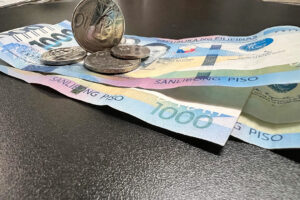




Philippines Trade Update: Trade trajectories trend along
 DOWNLOAD
DOWNLOAD

Policy Rate Updates: Double cut finale
 DOWNLOAD
DOWNLOAD

Monthly Economic Update: One for the road
 DOWNLOAD
DOWNLOAD


Peso rises on profit taking after BSP meeting

The peso ended higher against the dollar on Thursday despite testing a new 20-month low intraday, propped up by profit taking after the Philippine central bank maintained its policy stance for a sixth straight meeting.
The local unit closed at PHP 58.75 per dollar on Thursday, strengthening by 11 centavos from its PHP 58.86 finish on Wednesday, Bankers Association of the Philippines data showed.
The peso opened Thursday’s session slightly weaker at PHP 58.88 per dollar. Its weakest showing was at PHP 58.92, a level not seen since October 2022 and just eight centavos away from the peso’s record low of PHP 59 per dollar, while its intraday best was its close of PHP 58.75 versus the greenback.
Dollars traded jumped to USD 1.21 billion on Thursday from USD 720.25 million on Wednesday.
The peso rose on profit taking after the central bank held benchmark rates steady at its meeting on Thursday, a trader said via phone call.
The Bangko Sentral ng Pilipinas (BSP) kept its target reverse repurchase rate unchanged at 6.5% for a sixth straight time on Thursday, as expected by all 15 analysts in a BusinessWorld poll last week.
Interest rates on the overnight deposit and lending facilities were also maintained at 6% and 7%, respectively.
The central bank’s lower inflation forecasts also supported the peso, Rizal Commercial Banking Corp. Chief Economist Michael L. Ricafort said in a Viber message.
“The peso appreciated from local optimism after the BSP substantially lowered its medium-term inflation outlook, changing its assessment of risks from the upside to the downside,” a second trader said in text message.
The BSP on Thursday lowered its average baseline inflation forecasts for 2024 and 2025 to 3.3% and 3.1%, respectively, from 3.5% and 3.3% previously.
It also slashed its risk-adjusted inflation forecasts for this year and next to 3.1% from 3.8% and 3.7%, respectively.
Headline inflation accelerated to 3.9% year on year in May from 3.8% in April, but marked the sixth straight month that inflation settled within the central bank’s 2-4% annual target.
For the first five months, the consumer price index averaged 3.5%.
For Friday, the second trader said the peso could strengthen further ahead of the release of the May US personal consumption expenditures (PCE) report.
The second trader sees the peso moving between PHP 58.60 and PHP 58.85 per dollar on Friday, while Mr. Ricafort expects it to range from PHP 58.65 to PHP 58.85.
Meanwhile, the yen languished near a 38-year low on Thursday and struggled on the weaker side of 160 per dollar, keeping markets on alert for any signs of intervention from Japanese authorities to prop up the currency, Reuters reported.
In the broader market, the dollar pared some of its gains from the previous session as US Treasury yields eased a touch, though it held near an eight-week high against a basket of currencies.
The yen rose 0.2% to 160.47 per dollar, having fallen to a low of 160.88 on Wednesday, its weakest since 1986.
The Japanese currency has fallen some 2% for the month and 12% for the year against a resilient dollar, as it continues to be hammered by stark interest rate differentials between the US and Japan, which has maintained the appeal of using the yen as a funding currency for carry trades.
The dollar index dipped 0.13% to 105.91, not far from a nearly two-month high of 106.13 hit on Wednesday.
Currency moves outside of the yen have been largely subdued for the most part of the week, as traders await Friday’s US core PCE data — the Federal Reserve’s preferred measure of inflation, for further clues on the US rate outlook. — AMCS with Reuters
This article originally appeared on bworldonline.com





 By BusinessWorld
By BusinessWorld